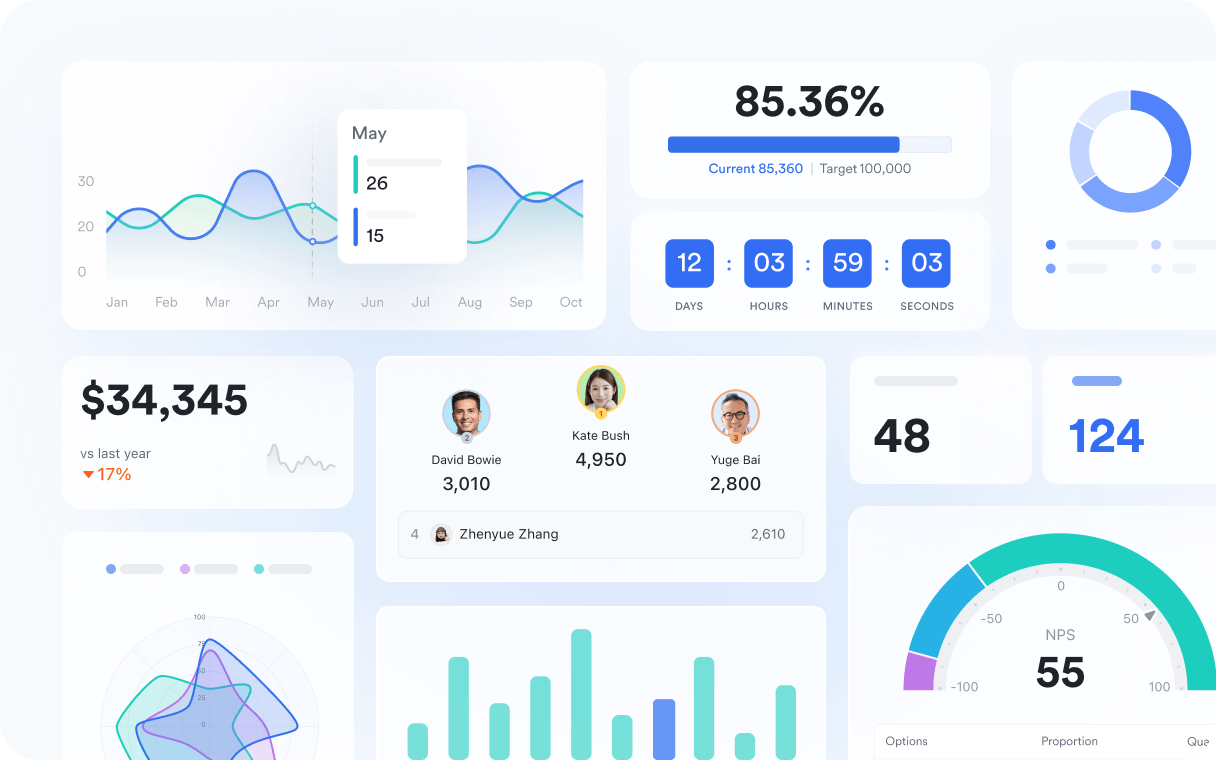Many companies find that customers judge them on how well they work together, just as much as they judge the final product. If expectations aren’t in sync, updates are missed, or emails get lost, trust disappears fast. Old-school ways of handling client work, think emails, spreadsheets, and chat apps all over the place – make this even riskier. Clients end up feeling like things are a mess.
But, project management tools today are switching things up. Instead of gathering bits of info from all sorts of places, businesses can now work with clients on platforms that keep everything together. For example, Lark shows how bringing projects, communication, and getting things done into one place not only makes things faster but also turns the client experience into one where they feel confident, like things are open and honest, and that they’re part of a team.
Lark Base: Structuring client projects clearly
Every successful client relationship depends on visibility. Without it, updates are late, deliverables get lost, and clients feel left in the dark. Lark Base creates the shared foundation where client projects are structured clearly, with updates always accessible.
For example, sales teams can configure a CRM app in Base to track client relationships, ensuring history and context remain tied to active projects. Once a contract is signed, the same record feeds directly into deliverables for marketing, operations, or support. Clients see that nothing falls through the cracks between teams.
Base also adapts to different project styles. A design agency might use gallery view to showcase deliverables, while a logistics firm relies on timelines to track shipments. For clients, the result is the same: clarity on progress and confidence that commitments will be met.
Lark Mail: Connecting external and internal communication
Email is still the main way to talk to clients, but it can be a mess when it’s all over the place. Say someone approves something in an email, but the team doesn’t see it and keeps going. That’s a problem. Lark Mail fixes this by putting client emails right where the project is.
So, if a client says yes to something in an email, that email can connect straight to the project or turn into a to-do. Files stay with the right project, so no one’s confused about which one’s the correct one. Instead of forwarding emails, the team just sees updates right away.
Clients see this as professional and trustworthy. They can tell that what they say actually turns into progress, which makes them trust the team even more.
Lark Docs: Making collaboration transparent
Clients want to feel included in the process, not left out until final delivery. Lark Docs enables transparent collaboration by creating living documents where ideas, drafts, and plans evolve openly.
A consulting firm preparing a strategy report can invite clients to view or comment in real time. Instead of endless email chains, feedback is centralized and visible to everyone. Changes are tracked clearly, ensuring accountability on both sides.
Docs also link to Tasks and Calendar events, turning client feedback into actionable next steps. The process becomes smoother, and clients see their input respected and acted upon without delay.
Lark Tasks: Driving accountability with automation
One of the biggest problems with projects is when no one is really in charge of getting things done. Someone says they’ll deliver something, but it’s not clear who’s actually responsible, so deadlines get missed. Lark Tasks fixes this by putting responsibility right into how things get done.
Managers can assign tasks with deadlines, and workers can keep track of them on their own dashboards. Everyone involved, even the people talking to clients, can see how things are going. This makes sure nothing gets done twice and nothing slips through the cracks.
Also, Tasks has an automated workflow. It sends reminders, flags late work, and updates everything without anyone having to do it by hand. For clients, this means fewer late deliveries and a reliable time after time. For teams, it means things go smoothly, even when things are hectic.
Lark Meetings: Turning conversations into outcomes
Meetings with clients often risk becoming repetitive status updates. Time is spent recapping rather than making progress. Lark Meetings changes this by embedding collaboration into the flow of discussion.
Teams join meetings directly from Calendar, open shared Docs for live note-taking, and assign Tasks during the session. Clients don’t just hear updates they see action items captured and responsibilities assigned on the spot.
If someone cannot attend, recordings and transcripts ensure continuity. Clients feel assured that nothing is missed, and teams avoid the inefficiency of repeating conversations. Meetings stop being overhead and become productive moments of alignment.
Lark Sheets: Making data accessible and actionable
Data is super important for keeping clients happy, whether it’s tracking how a campaign is doing or looking at money predictions. But it can be a pain when all that data is stuck in boring spreadsheets that are hard to share. Lark Sheets puts data where everyone can see it and actually use it.
Teams can work on Sheets together as it happens, putting them right into Docs or Base records. For example, a marketing company can show a client how a campaign is going, and the client sees the numbers change live. Or, a finance company can make predictions together with a client, so everyone’s on the same page.
This openness helps build trust. Clients don’t feel left out waiting for reports; they see the data as it changes, which makes them feel good about the relationship.
Conclusion
Working with clients isn’t just talking anymore, it’s about getting everyone on the same page. Simple solutions can deal with some things, but they mess up clients and slow things down. Easy-to-use systems such as Lark fix the mess by being open and reliable.
Lark structures projects so they are easy to see, Mail sticks clients talk about doing the work, Docs make working together open, Tasks add responsibility with automatic reminders, Meetings make sure talk leads to action, and Sheets make data easy to get right away. These things change how groups work with clients—making quick tasks into real partnerships.
For firms fighting in tough markets, this is big. It changes how trust is built and value is given. Systems that work create stronger ways to work.

